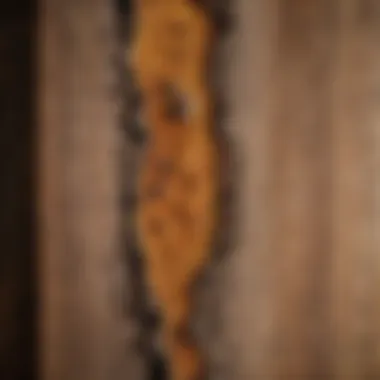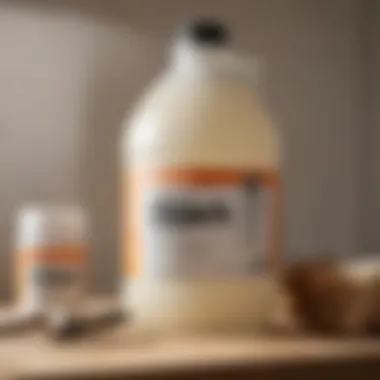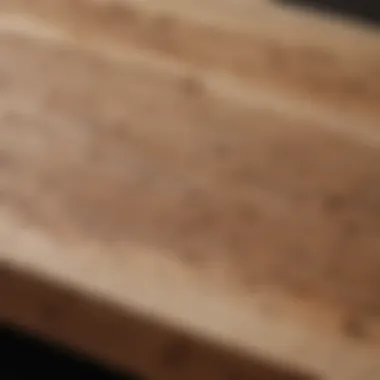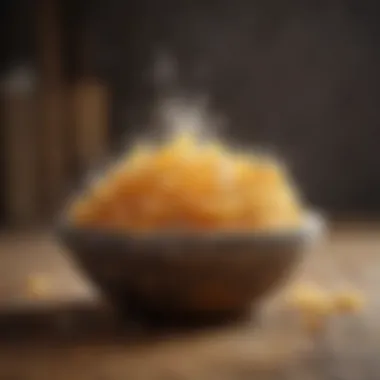Using Bleach to Effectively Remove Mold from Wood


Intro
Mold thrives in humid environments, and wooden surfaces can become a prime target. Utilizing bleach as a mold remover can be effective. However, informed usage is crucial for both effectiveness and safety. Understanding the types of mold, application methods, safety precautions, and alternatives broaden your knowledge about mold removal from wood. This guide will equip you with the necessary insights, allowing you to maintain mold-free wooden surfaces effectively.
Understanding Mold on Wood
Before considering removal techniques, you should recognize the types of mold commonly found on your wooden surfaces. Molds like Aspergillus, Penicillium, and Stachybotrys may develop on organic surfaces, producing potential health risks. Recognizing these molds can help you decide the best approach for effectively treating them with bleach.
Key Properties of Bleach
Bleach, or sodium hypochlorite, acts as a powerful cleaning agent against many household pathogens. Its wide availability, both in liquid and powdered form, combines effectiveness with convenience. It penetrates wood surfaces, reaching the unseen portions of molds, amplifying its efficacy. However, overuse or improper application risks damaging the wood and can pose health hazards.
Preparation Steps
Preparing yourself before engaging in mold removal requires gathering tools and taking safety measures. You'll need:
- Gore gloves and safety goggles
- Mask to protect breathing
- Soft-bristle brush or cloth
- Bucket for mixing
- Sprayer or sponge for application
- Plastic sheets to protect surrounding areas
Before you start, ensure adequate ventilation. Open windows or use fans to circulate air.
Steps for Using Bleach on Molded Wood
- Mix a solution of one part bleach to three parts water in a bucket.
- Use gloves and goggles while handling bleach to protect your skin and eyes.
- Test a small, hidden area of wood surface to ensure there is no discoloration or damage.
- Apply the solution generously using a brush or sponge. Let it stand for 10-15 minutes.
- Scrub away the mold. Pay close attention to edges or seams where mold may linger.
- Rinse the area thoroughly with clean water to neutralize the bleach.
- Allow the wood to dry completely before sealing or painting.
Post-Treatment Considerations
Potential discoloration from bleach treated wood is common. If this is a concern, apply a wood conditioner or reseal with a suitable finish. For ongoing prevention, regularly inspect wooden areas prone to dampness. Apply mold inhibitors as needed for further protection.
Safety Precautions
When using bleach, adhere to the following guidelines:
- Read instructions on all bleach labels carefully.
- Avoid mixing bleach with ammonia or other cleaning solutions.
- Wear protective gear throughout the entire process.
Always ensure proper disposal methods for bleach waste. Environmental considerations play a crucial role in maintaining a safe household and ecosystem.
Alternatives to Bleach
For individuals looking for milder options, consider vinegar, baking soda, or hydrogen peroxide as replacements. These alternatives are less harsh on wood and can still mitigate mold issues effectively. Each has distinct application methods and effectiveness depending on mold type and extent of infestation.
By following the insights discussed in this guide, you reinforce your list of tools within a chore of maintaining clean and mold-free wooden surfaces.
Understanding Mold Growth on Wood
Mold growth on wooden surfaces is more than just an aesthetic issue. It indicates underlying environmental factors that can lead to significant damage over time. By gaining an understanding of how mold develops on wood, homeowners can manage infestations more effectively and keep their wooden assets in optimal condition.
What is Mold?
Mold is a type of fungus that can grow in various environments, thriving in moist, warm areas. It appears as small spots which may be black, green, or any shade in between. Molds reproduce by releasing spores into the air, which can trigger allergic reactions and respiratory problems. Understanding mold helps in taking proper precautions and techniques necessary for removal.
Why Mold Thrives on Wood?


Wooden materials provide an excellent nutritional base for mold growth due to their organic composition. Factors such as dampness and poor ventilation contribute to this growth. Furthermore, the cellulose in wood acts as food for mold. Areas that experience high humidity levels or frequent water exposure, like basements or bathrooms, are particularly susceptible. Ignoring these conditions often allows mold colonies to develop without restriction.
Signs of Mold Infestation on Wood
Detecting mold early can prevent extensive damage. Common indications of mold on wooden surfaces include:
- Visible discoloration: If parts of wood begin to take on a greenish or blackish hue.
- Neglectable odors: A musty smell in wooden areas often indicates mold presence.
- Deteriorating wood: Weak or crumbling wood furniture and structures may be a result of mold damage.
Quick detection is crucial to act efficiently against mold. Regular monitoring can save hardwood and maintain a safe environment.
Chemical Properties of Bleach
Understanding the chemical properties of bleach is crucial for effectively removing mold from wood. Bleach, particularly sodium hypochlorite, is commonly used for its disinfecting abilities. It achieves stability as a solution, allowing it to effectively penetrate surfaces, making it a favored choice for treating mold. However, recognizing its strengths and limitations is important.
Composition of Bleach
Bleach essentially consists of water and sodium hypochlorite. The percentage of sodium hypochlorite can vary among different formulations. Typically, household bleach contains around 4-6% sodium hypochlorite, while industrial versions may be higher.
Additionally, you may find stabilizers and other chemical agents included to enhance effectiveness and shelf life. Understanding that composition helps Professionals determine the appropriate dilution rates for mold removal.
How Bleach Interacts with Mold
Bleach reacts with organic materials, such as mold spores, through a chemical oxidation process. When applied to mold, sodium hypochlorite breaks down the cellular structure of the spores, leading to their destruction. However, it is vital to note that bleach lacks the ability to penetrate porous materials deeply; hence, any mold hidden within wood grain might not be completely removed.
This interaction not only disinfects the surface but also can prevent further growth. It's noteworthy that the potential to damage underlying wood and finishes adds a layer of caution to the process. Consider monitoring effects on wood integrity and also adhere closely to safety guidelines when utilizing it.
Bleach acts on mold's cellular structure, critical for effective treatment but requires awareness of limitations regarding penetration and material compatibility.
Preparing for Mold Removal
Preparing for mold removal is a vital stage to ensure both effectiveness and safety. Unorganized efforts can lead to ineffective results and potential health hazards. A systematic approach sets the foundation for effective mold remediation. Understanding your next steps can minimize damage and risks significantly.
Gathering Necessary Supplies
Before beginning the removal process, it is essential to collect all necessary supplies. This prevents interruption later. Key items include:
- Bleach: Use unscented, standard liquid bleach for mold removal, typically containing 5.25% to 8.25% sodium hypochlorite.
- Water: For proper dilution of bleach. For safety, use cool water as warm can vaporize bleach much quicker.
- Protective Gear: Include gloves, a mask, and goggles to shield yourself from bleach fumes and spores.
- Spray Bottle or Bucket: For application, a spray bottle is effective for comprehensive coverage.
- Scrub Brush: Use a stiff-bristled brush for scrubbing away mold.
- Rags or Cloths: For cleaning and wiping the surface post-treatment.
Gathering ppropriate supplies not only mak the process smoother but also more effective. Each item plays a specific role in the eradication tactic.
Assessing Extent of Mold Damage
Prior to any corrective actions, assessing mold damage is a necessary step. Understanding the extent of infesation can inform the strategy for remediation. Questions to consider include:
- How widespread is the mold? Determine if it's localized or extensive to guide the removal process.
- What type of wood is affected? Different wood finishes may react uniquely to bleach.
- Any structural concerns? For significant damage, professional help may be essential.
By making careful assessments, you can choose the right remediation strategy without overreacting to smaller, easily treatable issues. Proper evaluation among the task at hand minimizes health risks and stabilizes the wooden structures.
Safety Precautions Before Using Bleach
Using bleach can pose health risks if safety measures are not followed. It is important to take precautions:
- Ventilation: Ensure the area is well-ventilated. Open windows and use fans to decrease fume build-up.
- For don protective gear: As stated earlier, gloves, masks, and goggles are non-negotiable. Skin exposure can lead to irritation, whereas inhalation has serious implications.
- Keep pets and people away: Restrict access to the work area during treatment. Exposure for pets and individuals can lead to unnecessary risk.
- Read the label: Always follow manufacturer’s instructions. Understanding dilution ratios will avoid oposed reactions to bleach.


Safety should always take priority. Taking these precautions minimizes risks associated with mold removal.
Preparing systematically guarantees that challenges and risks are accounted for ahead of time. The future well-being of wooden surfaces—and those managing them—depends on thorough preparation.
Step-by-Step Guide to Using Bleach on Wood
Using bleach to remove mold requires clear processes and careful execution. A step-by-step guiding method will ensure effectiveness and safety in application. This section focuses on crucial methodologies, enhancing your understanding of bleach usage on wood surfaces while acknowledging essential factors.
Diluting Bleach Correctly
Diluting bleach is very critical to maintain its effectiveness without damaging the wood. Typically, a standard ratio of one cup of household bleach to one gallon of water is seen. It is important to mix bleach and water in a well-ventilated area. This minimizes the risk of inhalation of harmful fumes when handling bleach.
When diluting, use a plastic or glass container to avoid any reaction with metal. Make sure to stir the solution gently, avoiding any splash. Correct dilution not only preserves the wood integrity but also maximizes the removal potential on mold.
- Always wear protective gear, including gloves and goggles, when handling bleach.
- It may be helpful to label the container once mixed, to prevent accidental misuse.
Application Techniques
Applying the bleach solution correctly is key in achieving favorable results. Several techniques work well, but a few best practices should be highlighted.
- Using a Sponge or Cloth: Dip a clean, absorbent cloth or sponge into your diluted solution, and apply it directly onto the moldy area of the wood. Press gently to allow the bleach to seep into the spores of the mold.
- Spray Bottles: For larger areas, a spray bottle can provide even coverage. Ensure that you spray from a distance of about six to eight inches. A fine mist will ensure the wood absorbs the solution evenly without leaving puddles, which can lead to further damage.
- Stiff-Bristled Brush: For stubborn mold or thick infestations, use a stiff-bristled brush. Gently scrub the afflicted area while applying the diluted bleach. Be cautious, because scrubbing too hard can strip the wood's finish.
Following applications, always monitor the area. If you see mold returning, revisit the treatment process to apply another round of sanitation.
Rinsing and Drying the Treated Area
Once you complete applying the bleach, the next step is rinsing and drying properly. This phase is often overlooked but is just as essential to eradicate mold effectively.
Start by rinsing any residue left from the bleach using clean water. A sponge or cloth can suffice, especially for small areas. For larger sections of wood, a garden hose can help rinse off all bleach thoroughly. Take care not to saturate the wood too much, as this can lead to swelling or warp.
Allow the wood to dry completely. Proper drying prevents any remaining mold spores from re-establishing. Ideally, you want to keep the area well-ventilated during this drying phase. Utilize fans or dehumidifiers, especially in poorly ventilated areas.
Inadequate rinsing or drying can not only affect the effectiveness of your cleaning but can lead to further mold growth. Be diligent in this phase!
After following these steps meticulously, not only have you treated current mold infestations but have also laid the groundwork for future prevention strategies.
Aftercare and Maintenance
Aftercare and maintenance are vital components when dealing with mold removal from wooden surfaces. This section outlines strategies and actions to take after using bleach, emphasizing the need for ongoing vigilance in keeping mold at bay. By instituting a regimen that focuses on care, one can fortify structures against future infestations while extending the longevity of the wood itself.
Preventing Future Mold Growth on Wood
Preventing future mold growth is an essential consideration once initial removal has been successfully conducted. The presence of moisture contributes significantly to mold proliferation; therefore, controlling the environment is crucial. Here are several practical actions to minimize the risks of mold recurrence:
- Control Humidity Levels: Maintain indoor humidity below 60%. Using dehumidifiers and humidistats can help monitor levels.
- Proper Ventilation: Ensure adequate ventilation in areas such as basements, attics, and kitchens, which are prone to moisture buildup. Use exhaust fans responsibly.
- Dry Spills Promptly: Any liquids that spill on wooden surfaces should be wiped up immediately to prevent water seepage.
- Seal Wooden Surfaces: Applying sealants can hinder moisture absorption in wood, creating a protective barrier against potential mold exposure.
- Observe Landscaping: Redirect water away from wooden structures by adjusting landscaping elements. Ensure gutters are clean and functional.
Each of these steps contributes to keeping wooden surfaces safer, inadvertently assisting in maintaining overall structural integrity as well.
Regular Inspection of Wooden Surfaces
Regular inspection is a proactive strategy in mold prevention on wooden surfaces. Frequent checks allow early detection should a problem arise. Ensuring that this practice is part of routine wood maintenance can save enormous amounts in restoration efforts. Here is how to carry out inspections efficiently:


- Visual Assessments: Regularly check for discolored patches, particularly in areas commonly exposed to moisture, such as corners and behind furniture.
- Feel for Dampness: Assess surfaces for dampness, especially after heavy rainfall or significant moisture events. A simple touch can reveal hidden problems.
- Inspect for Damage: Investigate whether the wood has soft spots or any deformations, which may indicate prior water damage, be alert for signs of deterioration during inspections.
- Schedule Monthly Check-ups: By incorporating a monthly regimen, you can instigate a mindset of awareness and reduce the overall risks associated with mold regrowth.
By combining these actions in both preventive measures and regular inspection routines, home and structure owners can better safeguard their wooden assets against mold infestations. This diligence may result in significant material preservation and long-term care of wooden surfaces, crucially allowing homes to breathe in an optimal environment. Anytime trouble is noticed, addressing swiftly can mitigate potential outcomes.
Potential Risks of Using Bleach
Understanding the potential risks associated with bleach is essential. It is prevalent as a cleaning agent, yet it is necessary to recognize the safety aspects linked to its use, especially when dealing with mold on wood. Ignoring these concerns could lead to health implications or damage to the material.
Health Concerns Associated with Bleach
Using bleach can pose various health risks, particularly if precautions are inadequate. When bleach is inhaled or comes into contact with skin, it may cause irritation or adverse reactions.
- Respiratory Issues: The fumes released from bleach can irritate the nasal passages, resulting in coughing or difficulty breathing. People with existing respiratory problems like asthma may experience heightened complications.
- Skin Exposure: Direct contact with bleach can lead to rashes or chemical burns. It is advisable to wear protective clothing, such as gloves and masks, to prevent any harm.
- Eye Damage: If bleach splashes into the eyes, it can cause severe damage. This risk underlines the need for goggles while handling the substance.
To mitigate these hazards, ensure proper ventilation by opening windows during cleaning. Additionally, always read and follow the specific safety labels on the product you are using.
"Proper precaution is not merely a practice; it is a necessity when using potent cleaning agents like bleach."
Impact on Wood Integrity
Aside from health risks, using bleach can damage the wood itself. Prolonged exposure may lead to undesirable changes. Keeping the welfare of your wood surfaces in mind is crucial.
- Surface Degradation: Bleach can strip wood of natural oils, causing it to dry and crack. This phenomenon makes the wood more susceptible to damage and decay over time.
- Color Changes: When bleach is applied, the brightening effect can sometimes result in uneven coloration or discoloration of the wood. This inconsistency may affect the aesthetic appeal, discouraging its use on surfaces where appearance is essential.
- Structural Weakening: Excessive use of bleach can deteriorate the structural integrity. Flooded areas or direct applications can harm not only the surface layer but the interior fibers, potentially making the wood less stable.
Therefore, knowing both health concerns and wooden material impacts is crucial before deciding to use bleach as a mold removal solution.
Alternatives to Bleach for Mold Removal
Exploring alternatives to bleach for mold removal from wood surfaces is essential. While bleach can be effective, it can also have drawbacks, such as potential health risks and damage to wood integrity. Considering alternative options allows homeowners to find safer and often eco-friendlier solutions. Understanding these alternatives entails recognizing the effectiveness, safety, and specific uses that can suit diverse situations. As we begin, keep in mind that some methods may require more effort or time for results, but they can be viable options.
Vinegar Solutions
Vinegar is a natural and popular option for eliminating mold on wood. Its mildly acidic nature can help kill mold spores and prevent regrowth. Using vinegar involves simple steps:
- Use white distilled vinegar, which is cheap and easy to obtain.
- Apply unmixed vinegar directly to the affected areas using a spray bottle or cloth.
- Allow it to sit for at least an hour. Afterward, wipe the area clean with a damp cloth.
It's important to note that vinegar has a distinct smell. However, this often dissipates quickly. Vinegar performs well on non-porous surfaces, though wooden surfaces may require more thorough cleaning due to their porosity. Multiple applications may be necessary depending on the mold's extent.
Vinegar's effectiveness depends on the concentration. Higher concentration provides better results.
Baking Soda Applications
Baking soda is another effective natural alternative that can help in removing mold from wood. Its alkali properties work to neutralize the mold's environment. To utilize baking soda:
- Dissolve one quarter of a cup of baking soda in a spray bottle with water. This creates a simple yet effective solution.
- Spray the solution directly onto the mold-infested area.
- Scrub the area using a soft brush or cloth. This helps to lift the mold off the wood.
- Rinse with water and let it dry thoroughly.
Besides its mold-fighting abilities, baking soda is also non-toxic, making it safe for household use, especially where children or pets may be present. Regular applications may help to keep surfaces mold-free. While taking time and effort, the tactile benefits associated with baking soda solutions make it an appealing choice.
Finale
Understanding the best practices for mold removal is crucial. This article offers an extensive discussion on those practices, especially regarding the use of bleach for removing mold from wood surfaces. Having covered the various techniques, safety considerations, and potential risks, it is essential to emphasize that knowledgeable and pragmatic approaches will yield the best results.
Summarizing Best Practices
When tackling mold removal with bleach, follow these steps for effectiveness:
- Choose the Right Bleach: Ensure you use regular household bleach and avoid scented variants. This retains efficacy while preventing unwanted chemcial reactions.
- Dilute Correctly: The appropriate mix of bleach with water is vital. A common recommendation is a ratio of one cup of bleach to a gallon of water.
- Ventilation: Always work in a well-ventilated space. Open windows or use fans to dispel fumes, making the environment safer while doing this process.
- Test Surface: Before applying bleach broadly, spot test on a small area. This helps check for any adverse reaction with the wood.
- Follow Up: After rinsing off the bleach, ensure the wood dries adequately. Failure to do so can lead to further mold growth.
- Continuous Maintenance: Regularly inspect wooden surfaces, keeping them dry and clean to prevent future infestations.
In sum, learning how to effectively use bleach for mold removal enhances the longevity of wooden structures. Implementing thorough cleaning practices with informed methodologies results in safer and healthier environments.







